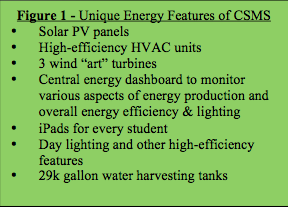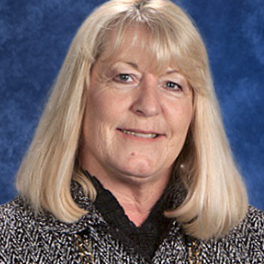Spotlight on Dr. Rhonda Frueauff, outgoing superintendent for the Ft. Huachuca Accommodation School District
Colonel Smith Middle School (CSMS) is a unique place of learning, not just because it serves military families in Southeast Arizona, but because it is also Arizona’s first net-zero energy school. “Net-zero energy” means that CSMS produces as much energy over a year as it uses to function and operate, mostly through solar panels on its rooftops. The project is the brain-child of Ronda Frueauff, the outgoing superintendent for the Ft. Huachuca Accommodation School District. Colonel Smith Middle School takes experiential learning to the next level by embracing sustainability though technology, and technology through sustainability. The result has been a unique institution that is laying a solid foundation for kids to continue in a future where high-tech skills and clean energy sense are becoming increasingly necessary.
Background
Dr. Frueauff has built overseen the construction of 12 schools in her career as a superintendent, including three new schools on the Ft. Huachuca base. She used this experience to fulfill her aspirations for a school that truly embraces experiential learning by embracing technology and clean energy. The vision for the school came from Dr. Frueauff’s personal research, her 30 years of experience as an educator, and sprang directly from a concept paper she authored on her model for experiential learning. “In order to engage students, you have to have an environment that is inviting and engaging… I want everything to be a learning environment from the time they get off the school bus, until the time they leave the building.”
Educational Features of the Net-Zero School
The school’s features allow students to learn about energy systems by monitoring energy  production and efficiency throughout the school at any time on their iPads (Figure 1). This “Energy Dashboard” measures the production of 37 energy sources, monitors how energy is being utilized, tracks the wind production and how it affects the grid, and measures the water harvesting that the school uses for irrigation. Each wind turbine has a slightly different design, allowing students to compare which types of energy production are more efficient and draw their own conclusions about renewable energy production and design. Another unique energy-saving feature of the school is the utilization of day lighting. On most days, the lights in the classroom are off during the lesson because of the extensive use of daylight that was the product of smart design and site planning, according to Dr. Frueauff.
production and efficiency throughout the school at any time on their iPads (Figure 1). This “Energy Dashboard” measures the production of 37 energy sources, monitors how energy is being utilized, tracks the wind production and how it affects the grid, and measures the water harvesting that the school uses for irrigation. Each wind turbine has a slightly different design, allowing students to compare which types of energy production are more efficient and draw their own conclusions about renewable energy production and design. Another unique energy-saving feature of the school is the utilization of day lighting. On most days, the lights in the classroom are off during the lesson because of the extensive use of daylight that was the product of smart design and site planning, according to Dr. Frueauff.
The success and comprehensiveness of the experiential learning and net-zero energy features of the school exceeded even her expectations, but that is not the only unique part of the school. In fact, going net-zero was not in the initial plan for the school. The school embraces a science, technology, engineering, and math (STEM) curriculum by including technology use into almost every element of education. Students have access to 3-D modeling software, film editing classes, iPads, and a high-caliber science and engineering program that prepares them for college-level classes when they matriculate to Sierra Vista High School. CSMS includes a specialized high school component for students who wish to continue their high-tech studies after graduation. CSMS supports up to 150 students who can stick with the program, allowing them to accelerate their learning at community college, and actually attain associates degrees by the time they graduate from high school.
Construction and Implementation
Dr. Frueauff explained that the implementation of her concept paper was a part of the school’s effort to keep her on board for a few more years. The Ft. Huachuca education board read and understood Dr. Frueauff’s paper, and gave her extensive latitude in fulfilling her vision for an experiential learning environment that prepares students for a high-tech, clean energy future. To Dr. Frueauff, CSMS was a particularly special outcome, because typically new school projects lack the funding and/or political will necessary to build such a cutting-edge facility. But the case of Colonel Smith Middle School “was so exceptional, I don’t know what I would have done differently. It [was] a once in a lifetime experience.” Dr. Frueauff said that the school’s construction was so successful because of an extraordinary team of experts, engineers, and a willing school board, combined with a military community that already understood and embraced high-technology education and clean energy. CSMS services hundreds of military families on the base at Ft. Huachuca, was also significantly bolstered by the U.S. military’s policy mandate to integrate clean and renewable energy into our military bases.
Students were involved from the initiation of the planning process: “students love the school and were part of the design process and dialogue.” Dr. Frueauff explained that students were able to provide direct input on proposed features of the school, including the use of iPads as part of the instructional program, furniture design, and increased independence and responsibility for their own education. The result is a unique educational environment. Dr. Frueauff hopes that CSMS can serve as a model that other schools will embrace as they pursue STEM-oriented curricula, sustainability, and experiential learning.


